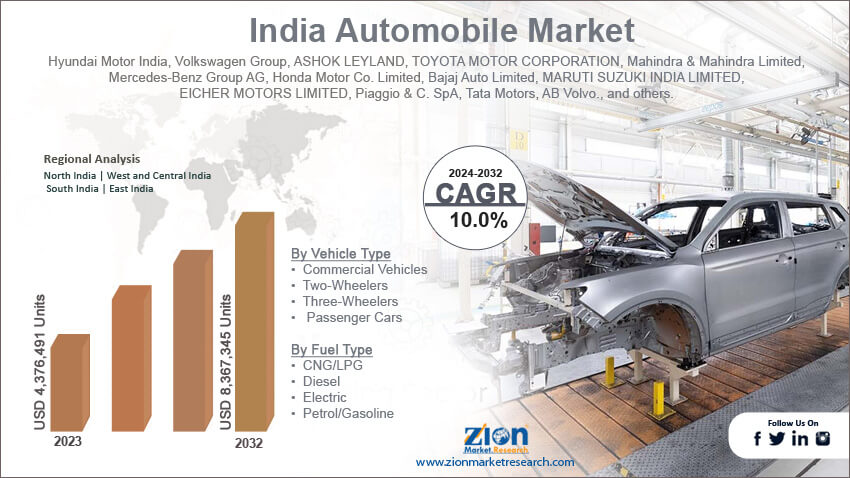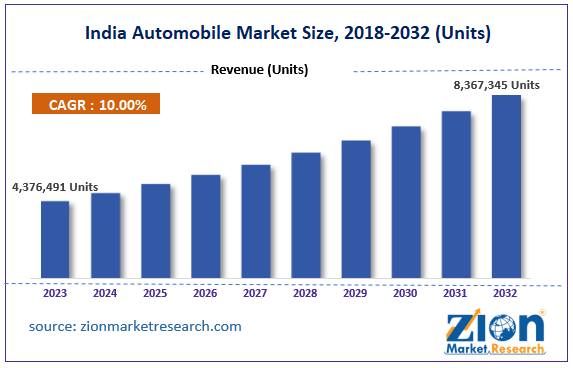India Automobile Market Size, Share, Analysis, Trends, Growth, 2032

India Automobile Market By Vehicle Type (Commercial Vehicles, Two-Wheelers, Three-Wheelers, and Passenger Cars), By Fuel Type (CNG/LPG, Diesel, Electric, and Petrol/Gasoline), and By Region - Industry Overview, Market Intelligence, Comprehensive Analysis, Historical Data, and Forecasts 2024 - 2032
| Market Size in 2023 | Market Forecast in 2032 | CAGR (in %) | Base Year |
|---|---|---|---|
| USD 4,376,491 Units | USD 8,367,345 Units | 10% | 2023 |
India Automobile Industry Prospective:
The India automobile market size was evaluated at 4,376,491 units in 2023 and is slated to hit 8,367,345 units by the end of 2032 with a CAGR of nearly 10% between 2024 and 2032.
India Automobile Market: Overview
The automotive sector is likely to flourish rapidly in India and its growth projection of sector in the country in terms of revenue will total nearly US$301 billion by 2026. A surge in the per capita income, an increase in the purchasing capacity of the consumers, a rise in the customer base, and growing urbanization have propped up the vehicle demand in the country.
Key Insights
- As per the analysis shared by our research analyst, the India automobile market is projected to expand annually at the annual growth rate of around 10% over the forecast timespan (2024-2032)
- In terms of revenue, the global India automobile market size was evaluated at nearly 4,376,491 units in 2023 and is expected to reach 8,367,345 units by 2032.
- The global India automobile market is anticipated to grow rapidly over the forecast timeline owing to humungous demand for sports utility vehicles along with the surging need for commercial vehicles in the logistics segment.
- In terms of vehicle type, the two-wheeler segment is slated to register the highest CAGR over the forecast period.
- Based on fuel type, the electric segment is predicted to contribute majorly towards the global industry growth in the upcoming years.
 Request Free Sample
Request Free Sample
India Automobile Market: Growth Factors
A rise in the demand for vehicles due to surging population can succor the market expansion in India over 2024-2032
Humungous demand for sports utility vehicles along with the surging need for commercial vehicles in the logistics segment is predicted to boost the growth of the India automobile market. In addition to this, technological breakthroughs in the automotive sector along with the launching of new batteries for electric vehicles are likely to pave the way for humungous growth of the market in India. Escalating demand for electric cars for the rapidly increasing population in India will steer the growth of the market in the country. Favorable government schemes are likely to influence the expansion of the market in India. Moreover, the large-scale acceptance of new technology in automotive and supply chain activities is likely to completely transform the overview of the automotive business in India.
India Automobile Market: Restraints
Strict legislation related to carbon emissions can put brakes on the industry in India by 2032
Strict emissions laws and a rise in the safety laws pertaining to automotive driving are likely to put brakes on the India automobile industry expansion. An increase in the raw component costs along with supply chain disruptions can decimate the growth of the India automobile industry.
India Automobile Market: Opportunities
Escalating demand for ride-sharing has resulted in huge growth of the market in India
Growing demand for shared mobility such as car sharing as well as ride-hailing along with the huge sales of connected vehicles is likely to open new growth avenues for the India automobile market. Moreover, the rise in the focus of firms on developing eco-friendly vehicles such as hybrid powertrains and electric cars is likely to prop up the business landscape in the country.
India Automobile Market: Challenges
A surge in vehicle prices can create hurdles in the expansion of the industry in India
Rise in vehicle costs due to a surge in tax & tariffs and supply chain disruptions can pose a huge deterrence to the expansion of the India automobile industry. Strict environmental laws regarding fuel emissions and changing consumer demand along with the unavailability of strong infrastructure facilities in 2-tier cities can severely impact the growth of the automotive sector in India.
India Automobile Market: Report Scope
| Report Attributes | Report Details |
|---|---|
| Report Name | India Automobile Market |
| Market Size in 2023 | 4,376,491 Units |
| Market Forecast in 2032 | 8,367,345 Units |
| Growth Rate | CAGR of 10% |
| Number of Pages | 227 |
| Key Companies Covered | Hyundai Motor India, Volkswagen Group, ASHOK LEYLAND, TOYOTA MOTOR CORPORATION, Mahindra & Mahindra Limited, Mercedes-Benz Group AG, Honda Motor Co. Limited, Bajaj Auto Limited, MARUTI SUZUKI INDIA LIMITED, EICHER MOTORS LIMITED, Piaggio & C. SpA, Tata Motors, AB Volvo., and others. |
| Segments Covered | By Product, By Technology, By End User, and By Region |
| Regions Covered in India | North India, West and Central India, South India, and East India |
| Base Year | 2023 |
| Historical Year | 2018 to 2022 |
| Forecast Year | 2024 - 2032 |
| Customization Scope | Avail customized purchase options to meet your exact research needs. Request For Customization |
India Automobile Market: Segmentation
The India automobile market is divided into vehicle type, fuel type, and region.
In terms of vehicle type, the India automobile market across the globe is bifurcated into commercial vehicles, two-wheelers, three-wheelers, and passenger cars segments. Additionally, the two-wheelers segment, which accrued nearly 53% of the global market revenue in 2023, is slated to register the highest growth rate yearly in the forecast time interval. The progress of the segment in the next few years can be due to the growing demand for fuel efficacy and cost-efficiency of two-wheelers in India. Moreover, a rise in the need for effective transportation and low fuel emissions has resulted in a huge demand for electric scooters in the two-tier cities in the country. Apart from this, the smart city concept has further added to the two-wheeler demand in India.
Based on the fuel type, the global India automobile industry is divided into CNG/LPG, diesel, electric, and petrol/gasoline segments. Furthermore, the electric segment, which garnered approximately 71% of the global industry earnings in 2023, is expected to make key contributions towards the global industry expansion in the forecasting timeline. The surge of the segment in the analysis timeline can be credited to strict laws implemented by the government of India to control fuel emissions along with favorable government initiatives such as providing subsidies for the purchase of electric vehicles.
Key Developments
- In the first half of 2024, Maruti Suzuki decided to establish a car manufacturing unit in Gujarat in India for producing 1 million cars yearly. Such moves are likely to provide impetus to the expansion of the automobile sector in India.
- In the first quarter of 2023, MG Motor India, a vehicle manufacturer based in India, launched Comet EV, the most cost-effective electric vehicle in India.
India Automobile Market: Competitive Space
The India automobile market profiles key players such:
- Hyundai Motor India
- Volkswagen Group
- ASHOK LEYLAND
- TOYOTA MOTOR CORPORATION
- Mahindra & Mahindra Limited
- Mercedes-Benz Group AG
- Honda Motor Co. Limited
- Bajaj Auto Limited
- MARUTI SUZUKI INDIA LIMITED
- EICHER MOTORS LIMITED
- Piaggio & C. SpA
- Tata Motors
- AB Volvo.
The global India automobile market is segmented as follows:
By Vehicle Type
- Commercial Vehicles
- Two-Wheelers
- Three-Wheelers
- Passenger Cars
By Fuel Type
- CNG/LPG
- Diesel
- Electric
- Petrol/Gasoline
By Region
- North India
- West and Central India
- South India
- East India
Table Of Content
Methodology
FrequentlyAsked Questions
The automotive sector is likely to flourish rapidly in India and its growth projection of sector in the country in terms of revenue will total nearly US$301 billion by 2026.
The India automobile market growth over the forecast period can be owing to technological breakthroughs in the automotive sector along with the launching of new batteries for electric vehicles.
According to a study, the India automobile industry size was 4,376,491 units in 2023 and is projected to reach 8,367,345 units by the end of 2032.
The India automobile market is anticipated to record a CAGR of nearly 10% from 2024 to 2032.
The India automobile market is led by players such as Hyundai Motor India, Volkswagen Group, ASHOK LEYLAND, TOYOTA MOTOR CORPORATION, Mahindra & Mahindra Limited, Mercedes-Benz Group AG, Honda Motor Co., Limited, Bajaj Auto Limited, MARUTI SUZUKI INDIA LIMITED, EICHER MOTORS LIMITED, Piaggio & C. SpA, Tata Motors, and AB Volvo.
The India automobile market report covers the geographical market along with a comprehensive competitive landscape analysis. It also includes cash flow analysis, profit ratio analysis, market basket analysis, market attractiveness analysis, sentiment analysis, PESTEL analysis, trend analysis, SWOT analysis, trade area analysis, demand & supply analysis, Porter’s five force analysis, and value chain analysis.
HappyClients
Zion Market Research
Tel: +1 (302) 444-0166
USA/Canada Toll Free No.+1 (855) 465-4651
3rd Floor,
Mrunal Paradise, Opp Maharaja Hotel,
Pimple Gurav, Pune 411061,
Maharashtra, India
Phone No +91 7768 006 007, +91 7768 006 008
US OFFICE NO +1 (302) 444-0166
US/CAN TOLL FREE +1 (855) 465-4651
Email: sales@zionmarketresearch.com
We have secured system to process your transaction.
Our support available to help you 24 hours a day, five days a week.
Monday - Friday: 9AM - 6PM
Saturday - Sunday: Closed






